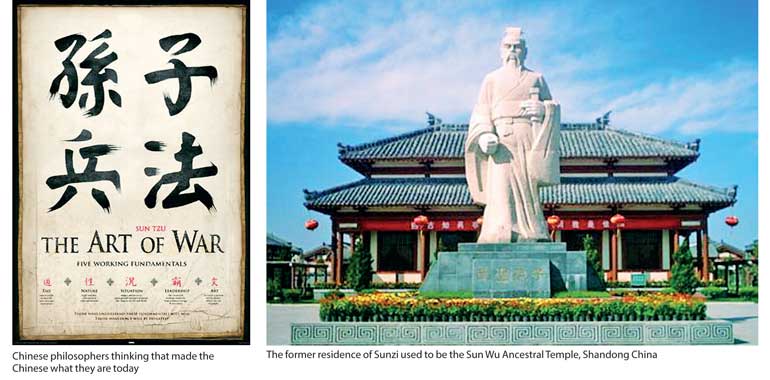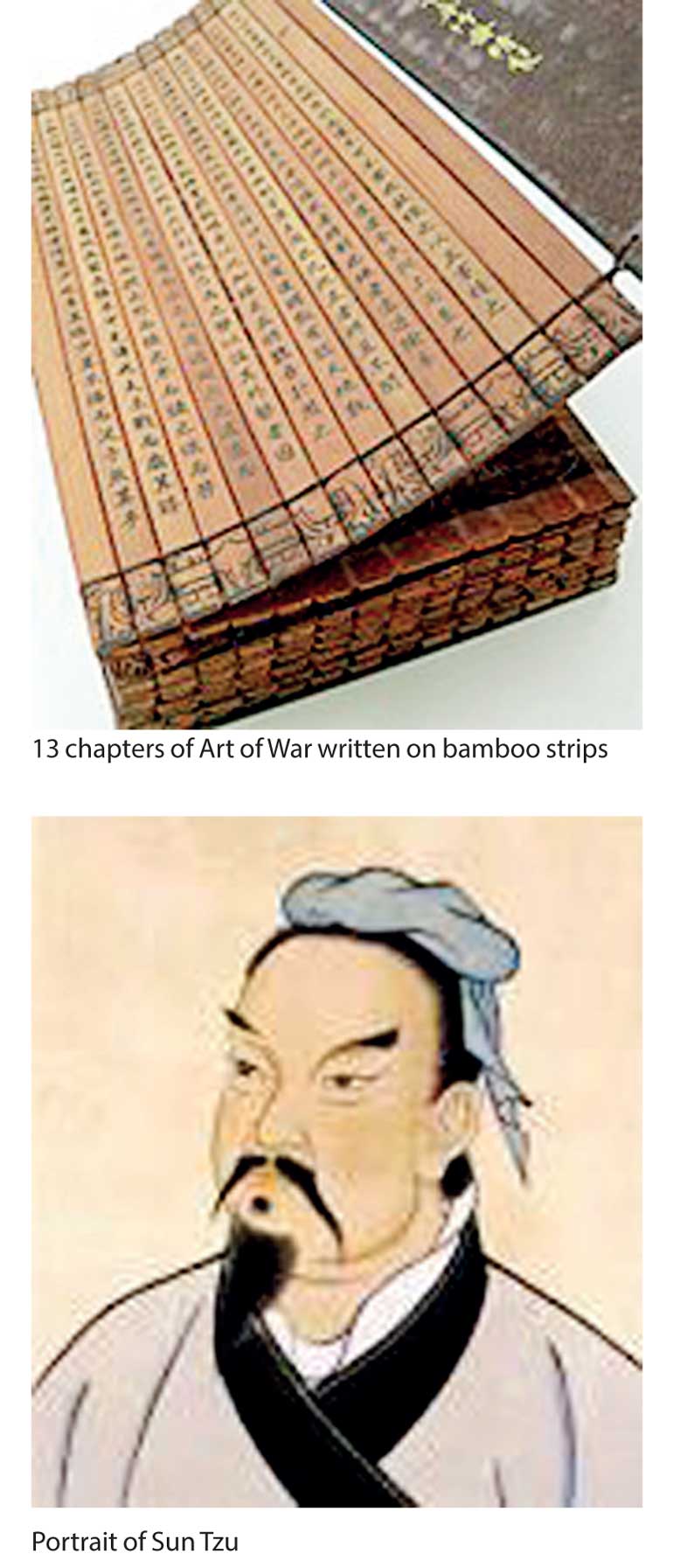Tuesday Apr 29, 2025
Tuesday Apr 29, 2025
Friday, 26 January 2018 00:00 - - {{hitsCtrl.values.hits}}


 It is said the Chinese are not easy to understand. Even governments and individuals deal with the Chinese not fully understanding them.
It is said the Chinese are not easy to understand. Even governments and individuals deal with the Chinese not fully understanding them.
The Chinese have gone through centuries of turbulent times and periods of great peace and prosperity. Saying this; many nations can claim that they too have gone through war and peace. What differentiates the Chinese is that they continuously struggled with foreign invasions, internal wars, famine, droughts for over 5,000 years.
China has been in turbulence for the last 300 years. In the last 500 years newly-emerged foreign powers such as the Portuguese, British, Americans, the Russians and finally the Japanese engaged the Chinese monarchy into war and carved parts of China after destabilising this once-powerful Middle Kingdom first with modern weapons and then subdued them with opium.
During the Cold War, the Western media portrayed the Chinese as evil, conniving and all out to conquer other nations. Interestingly enough the Chinese have not conquered or engaged in a prolonged war with any nation.
To understand the Chinese, one must understand their philosophy and culture. To appreciate the Chinese psyche, one must recognise the teachings of Laozi (604 BC-531BC), Confucius (551BC-479 BC), Sun Tzu (544BC-496 BC), Sun Bin (D 316 BC), Mencius (373 BC-289 BC), Dong Zhong Shu (179 BC-104 BC), Yang Xiong (53 BC- 18 AD), and recent philosopher Liu Zhi (1660-1739) who amalgamated Confucian thoughts with Islam and made such thinking spread across Northern China.
It must also be remembered that people never understand that “Chinese arts and crafts, writings, culture and philosophy changed after Buddhism was introduced from Afghanistan”. (‘Silk Road to Bamiyan’ – Sun Lai Yung).
Since President Nixon opened diplomatic relations with China, Chinese studies that was previously neglected came to prominence, especially military writings. Chinese military writings have extensively influenced 20th century thought in business and sports. Japanese, Korean and American strategists have studied deeply and re-evaluated the studies for non-military applications, focusing on tactics mainly in marketing, corporate strategy, mergers, takeovers, market share dominance and personal development.
Sun Tzu is the anglicised form while the Chinese refer to as Sun Zi (Sun Master.) He was named Sun Wu, born in Shandong Province in 544 BC in the State of Qi during the Zhou period. Until recently Sun Tzu and Sun Bin were considered one and the same.
A few decades ago in an accidental discovery at a construction site in Shandong Province, a tomb that belonged to Sun Bin (died 316) was unearthed with his treatise on bamboo strips also named ‘Art of War’. This accidental discovery clarified several doubts and consolidated the original work of Sun Tzu and subsequent writing by Sun Bin (‘Military Methods’) based on the theme of Sun Tzu’s original philosophy. Interestingly Sun Bin born in Shandong is a descendent of Sun Tzu and a military student of the Sun Tzu military school of thought.
Chinese history states that King Hu Lu of Wu discovers that his hostile neighbour intends to invade his kingdom. The King seeks Sun Tzu’s service and Sun Tzu assures the King that a small army of Wu can defeat a larger force. King Hu Lu challenges Sun Tzu to prove his military expertise by turning a harem of royal courtesans into an organised, well-trained fighting force. He asks the King to assemble all his concubines and court ladies. He then selects the favourite concubines to be the two leaders. Then he orders the exercise to begin with the roll of drums.
The concubines simply laughs and giggles. Then Sun Tzu tell the ladies: “May be my instructions were not clear; so let me repeat again.” He tells the ladies to assemble with their weapons and fall in line. This time too they laugh and giggle and ignore the command of the drum roll. Sun Tzu states: “If the orders are unclear, it’s the fault of the general for the troops not to obey; if the orders are clear, then it’s the fault of the subordinates for not obeying.” He beheads both concubines and appoints two new leaders. Then he beats the drum again and the ladies fall in line. For Sun Tzu, “War is a matter of life and death.” Discipline and an effective military force is of vital importance.
The book represents a philosophy of war, it teaches how to manage conflict and avoid confrontation. People generally assume that ‘Art of War’ teaches how to wage wars successfully. However, it’s a paradox where ‘Art of War’ teaches to avoid conflict and win battles without fighting. It is a military text, based on personal experiences and strategies devised by Sun Tzu. The book was used as a military text as part of learning and testing for imperial examination for military positions in ancient China.
Mao Tse Tung used Sun Tzu’s strategic tactics to evade the Kuo Mingtan headed by General Chang Kai Shek and the Japanese Imperial Army, two powerful forces during his struggle of the Communist revolution in China. This shows a rag tag army without heavy weapons, Tanks and aircrafts were able to defeat a superior army.
The success of Mao Tse Tung is the discipline of his soldiers, believing in Communist ideology and effectively using Sun Tzu strategy to retreat and attack at the right moment and when on a bad footing leave the terrain (Mao’s ‘The Long March’). ‘Art of War’ is mandatory reading for cadets at military academies, the KGB uses it heavily, and Japanese generals have studied the work and applied it successfully in their battles.
‘Art of War’ is a small book with 13 chapters. Most Westerners when reading a book on war strategy are puzzled that the book speaks on stability, harmony, moral values, balance and biding time. This type of thinking is paradox to war. However, Sun Tzu uses strategies of stability to create chaos, harmony to create discord, moral values of its own troops to create a demoralising factor in the enemy and balance to create scatter to the enemy.
How can we apply Sun Tzu’s war strategies to commercial and personal applications?
The 20th Century had two World Wars that changed borders and empires but also taught successive world leaders to apply peace and negotiations. ‘Art of War’ teaches the art of diplomacy, making the right alliances could avoid war or the alliance could pose such a threat that any contemplation of warfare will be discouraged. ‘Art of War’ also teaches how to apply tactically to use military strategy for commercial purposes.
Business leaders have taken this small in size but large in scope book to study and apply for marketing, takeovers and personal success. In business understanding the terrain is understanding the playing field, the market and your competitors.
“Know the enemy and know yourself; in a hundred battles you will never be in peril.” In business, use foresight and business intelligence to understand your competitor.
“When one treats people with benevolence, justice and righteousness, and reposes confidence in them, the army will be united in mind and all will be happy to serve their leaders.” Here Sun Tzu writes about treating employees fairly to achieve loyalty, higher productivity and higher profits. “Treat your men as you would your own beloved sons. And they will follow you into the deepest valley.”
Sun Tzu believes very strongly in leadership and his quotes (below) reflects his writing and can be applied even 2,500 years later. These strategies are used in trade union and labour negotiations. “To know your enemy, you must become your enemy.” Here in a trade union dispute one must ask what the opposite side wants and why. A powerful institution can crush a trade union unrest or negotiate to address genuine issues and win over the union members to work and fight for your profit.
Today China has emerged to be the second largest global economy with $ 12 trillion GDP in nominal value. China has a war chest of over $ 3 trillion foreign reserve and extended infrastructure-based loans to over a trillion to other nations. In comparison India’s GDP is $ 2.5 trillion and Russia GDP at $ 1.5 trillion. This is a comparative disparity of economies despite large geographic area and populations.
China’s President Xi Jin Ping advocates diplomacy and the cultivation of relationships with other nations as essential to its own growth. What does China want? China wants a ‘New World Order’. A world where nations are lifted from poverty, linking nations through new infrastructure development, which in turn develops ease of trade and removing cross border barriers.
President Xi Jinping understands Sun Tzu’s ‘diplomacy and state craft’. His One Belt One Road (OBOR) initiative exactly does that. China has the money and the technology to execute such an ambitious plan. No nation in the world can do it. Many nations talk, but can’t put the money down. Here China with its OBOR initiative has invited 66 countries to the ‘Modern Silk Road’.
To achieve the Modern Silk Road, airports, ports, highways, railways, power plants, communication, bridges, canals (Kra Canal in Thailand). Along with this infrastructure are the thousands of factories that will emerge to support the trade route. China wants to construct these projects with a green economy with minimal wastage and minimal environmental impact and sustainability.
China has taken the leadership role to the recent Paris Agreement on climate change issues and promised to reduce emission on a per capita basis by 2030. Today China is the largest solar panel producer. Coal power plants are gradually shut down and replaced by solar and wind power. All petrol combustion vehicle manufacturing will be replaced by electric vehicles by 2025.
After achieving global economic leadership, China wants to take the global political leadership role. Today America is caught up in wars in Syria, Iraq, and Afghanistan, politically it’s in a maelstrom with underdeveloped countries. China has taken the distraction of the world to position and prepare its global leadership position.
In May 2015 during the One Belt One Road Forum, President Xi said: “We have no intention to form a small group detrimental to stability, what we hope to create is a big family of harmonious co-existence.”
China wants to eradicate internal poverty before President Xi leaves office in 2022. China is a classic example when it comes to accelerated poverty elimination. OBOR is envisioned to do the same to the 66 participating countries. China realises that if its neighbours are poor, it will only create conflict and despondency. If its neighbours are economically well off, China is in a good position to trade with these nations and pull them out of low income status.
To finance the projects China has the Asian Infrastructure Investment Bank, (AIIB) and since 2013 there are 1,700 OBOR projects in progress. China has earmarked $ 4 trillion to be spent on OBOR-related projects by 2030. OBOR is beyond Silk Road and infrastructure, it’s a strategy to great economic expansion to 66 countries and beyond, soft diplomacy, mutual respect to developing nations and long-term friendship.
(Sun Lai Yung has worked in USA, Singapore, Afghanistan, Kuwait and Bahrain. He is currently employed as a consultant at a leading global company. He has a Masters degree in Economics from Northeastern University Boston. He will be writing and lecturing more on Sun Tzu strategies for business and military purposes. He can be contacted at [email protected].)
Discover Kapruka, the leading online shopping platform in Sri Lanka, where you can conveniently send Gifts and Flowers to your loved ones for any event including Valentine ’s Day. Explore a wide range of popular Shopping Categories on Kapruka, including Toys, Groceries, Electronics, Birthday Cakes, Fruits, Chocolates, Flower Bouquets, Clothing, Watches, Lingerie, Gift Sets and Jewellery. Also if you’re interested in selling with Kapruka, Partner Central by Kapruka is the best solution to start with. Moreover, through Kapruka Global Shop, you can also enjoy the convenience of purchasing products from renowned platforms like Amazon and eBay and have them delivered to Sri Lanka.
Discover Kapruka, the leading online shopping platform in Sri Lanka, where you can conveniently send Gifts and Flowers to your loved ones for any event including Valentine ’s Day. Explore a wide range of popular Shopping Categories on Kapruka, including Toys, Groceries, Electronics, Birthday Cakes, Fruits, Chocolates, Flower Bouquets, Clothing, Watches, Lingerie, Gift Sets and Jewellery. Also if you’re interested in selling with Kapruka, Partner Central by Kapruka is the best solution to start with. Moreover, through Kapruka Global Shop, you can also enjoy the convenience of purchasing products from renowned platforms like Amazon and eBay and have them delivered to Sri Lanka.